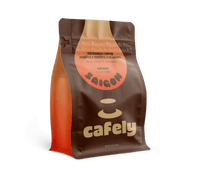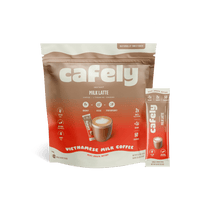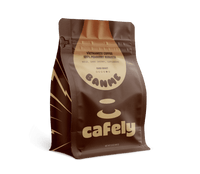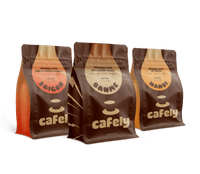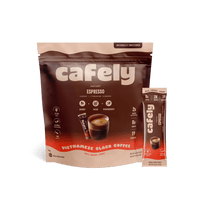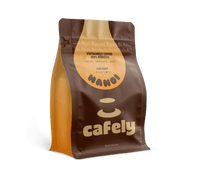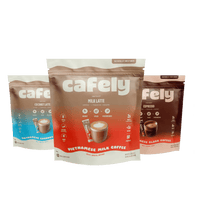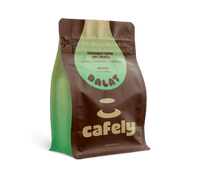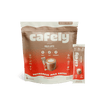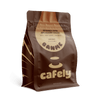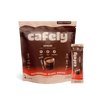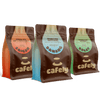A great latte starts long before the steamed milk — it begins with the beans. Pick the wrong ones, and you’ll end up with a thin, tasteless drink that no amount of steamed milk can save. But get it right, you’ll have a velvety-smooth, cafe-worthy masterpiece.
So, what are the best coffee beans for making a perfect latte? We’ll break down everything you need to know about this iconic, milk-based drink.
What Are the Best Coffee Beans for a Latte?
Tracking the best coffee beans for a latte needn’t be too complicated.
While we all have different preferences for taste, most expert baristas agree upon these factors when it comes to crafting lattes:
- Dark Roast Beans —The bold, rich flavors of dark roast beans, especially the chocolate undertones, pair perfectly with the creaminess of milk in a latte
- Fine Espresso Grind — A fine grind consistency allows for optimal extraction in an espresso machine, creating a strong and well-balanced base for the latte.
- Low Acidity — Beans with lower acidity, such as robusta variety or dark-roasted arabica, result in a smoother, more balanced flavor that compliments milk.
- Freshness — Recently roasted coffee beans retain their oils and flavors, creating a more aromatic and flavorful latte.
- Organically Grown — Choosing beans from an organic farmer means you’ll get a high-quality, pesticide-free product. Plus, these farmers use more environmentally-friendly practices.
- Certified Mold-Free — When beans are shipped internationally, they may grow mold in storage. This can leave behind mycotoxins, a dangerous chemical. When buying beans, make sure the company provides mold-free certification so you know you’re drinking 100% safe coffee.
The best beans for a latte are dark roast arabica beans, finely ground for espresso brewing. This fine grind should allow for great extraction in the high-pressure environment of an espresso machine, leading to a powerful flavor and an impressive body.
You can find our top picks below.
Roundup: The Best Coffee for Lattes
Here are our recommendations for the best coffee beans for your latte. Their bold, indulgent flavors can come through impressively well in any drink, but shine in a long, smooth option like a latte.
1. SaiGon OG Coffee (Robusta x Arabica x Peaberry)
 The SaiGon OG Coffee is Cafely’s flagship coffee and contains three different kinds of beans in one bag. Robusta and arabica beans are the stars of the show — the robusta gives each cup a rich, potent flavor that perfectly balances the bright and aromatic notes that the arabica beans bring to the table. The roasters included just a touch of premium quality peaberry beans to give the coffee a bold flavor.
The SaiGon OG Coffee is Cafely’s flagship coffee and contains three different kinds of beans in one bag. Robusta and arabica beans are the stars of the show — the robusta gives each cup a rich, potent flavor that perfectly balances the bright and aromatic notes that the arabica beans bring to the table. The roasters included just a touch of premium quality peaberry beans to give the coffee a bold flavor.
The roasters process these beans enough to produce a rich, balanced flavor while ensuring the subtle undertones of the arabica are not overwhelmed. The result is a harmonious blend that celebrates these three Vietnamese coffee varieties.
2. DaNang Coffee (Arabica x Robusta)
 DaNang features arabica and robusta beans in a medium-dark roast to create a delicious and complex flavor. This combination of beans creates a smooth and balanced taste with notes of hazelnut and maple syrup, reminiscent of the traditional Italian practice of adding around 10% robusta beans to an espresso.
DaNang features arabica and robusta beans in a medium-dark roast to create a delicious and complex flavor. This combination of beans creates a smooth and balanced taste with notes of hazelnut and maple syrup, reminiscent of the traditional Italian practice of adding around 10% robusta beans to an espresso.
We’ve upped the robusta content to make a blend that’s around fifty-fifty between the two beans. This gives the beans an impressively dark flavor with a subtle background flavor of citrus commonly found in arabica beans.
3. DaLat Coffee (100% Arabica)
 The DaLat Coffee is 100% arabica and packed with flavor. Paired with an expert dark roast, you’ll find a sweet, full-body cup of coffee with notes of caramel, blackberry, and stone fruit.
The DaLat Coffee is 100% arabica and packed with flavor. Paired with an expert dark roast, you’ll find a sweet, full-body cup of coffee with notes of caramel, blackberry, and stone fruit.
To get the best flavors out of these beans, you want to brew them with high extraction methods. For example, using the DaLat to make an espresso will lift out the complex flavors to complement steamed milk.
What Makes a Latte a Latte?
There are two defining factors that make a latte:
1. Milk to Coffee Ratio
A latte is typically made up of a ratio of three parts steamed milk to one part espresso (3:1). With a double espresso shot, this makes an 8 oz (240 mL) cup, which is generally considered an appropriate size for a hot drink. For larger or smaller sizes of latte, the ratio is typically maintained, though with different total amounts of milk and coffee.
2. Microfoam
Microfoam refers to milk that has been steamed gently to create a thick, shiny texture with uniform microbubbles. This is considered a core tenet of lattes.
The History of the Latte
The story of the latte started in Italy. Italians loved (and still love) espresso-based coffee. As espresso machines evolved and improved over time, milk became easier and easier to steam. In that context, the steamed milk was referred to as “latte” in Italian. Mixing that latte with coffee resulted in a caffè latte — translating to “coffee milk.”
Though Italians generally prefer plain espresso or cappuccino coffee, latte offered tourists, particularly Americans, a long, more palatable drink to make espresso easier to drink — similar to why Americano coffee was created.
Where Did Latte Art Come From?

From simple hearts and leaves to more elaborate designs, you may have come to expect some sort of latte art on your cup. But, where did this practice originate, and how is it achieved?
How Latte Art Is Made
As a concept, latte art is very straightforward. The dark espresso and the white, steamed milk in your pitcher offer contrasting colors. By combining these two elements in the right way, you can create a pattern on the top of the final drink featuring both the white milk and a lighter brown from mixing the foamed milk with the dark coffee.
However, the actual mechanics of this are much more complex than you might think. The process relies on placing the steam wand into the milk at precisely the correct direction and depth. By incorporating air and heat into the milk to add bubbles, it gets “stretched.” As the milk is steamed hotter and hotter, the fat content captures more of the small bubbles. With practice, you can create milk with a “wet paint” consistency ideal for latte art.
The Origins of Latte Art
The technique of stretching milk to create latte art and microfoam was likely pioneered in Italy, the first place steam-capable espresso machines were widely adopted. There are many anecdotal stories of people steaming milk to create beautiful drinks, with the more conventional latte art shapes linked to the late eighties and early nineties.
As the mark of a skilled barista who has taken care of your drink, latte art has become popular simply because it’s pretty. In a sense, its popularity is linked to why we drink coffee in general — it brings us joy.
Why Do We Add Flavor to Lattes and Not Other Coffee Drinks?
Let’s dive into a bit of the history behind flavoring coffee.
Traditional Flavored Coffees and Syrups
People have long doctored their espresso with different sugars and liqueurs to make fun and exciting drinks. Other cultures do the same thing. Take Vietnam for example, Vietnamese Coffee is a strong robusta coffee brewed with a phin filter, then mixed with condensed milk and served over ice.
But flavored syrups have long been a part of Italian culture. They’d mix syrups like tamarind, anise, and lemon with soda water to create a refreshing, sweet drink for the summertime.
So how did syrups end up in our lattes? Italian immigrants brought these syrups to the US where Americans decided to combine them with their brews.
The Birth of the Flavored Latte
Flavored latte is attributed to a single man — L. C. Brandenburg. As a retired coffee industry professional, he recognized the potential of mixing syrups and coffee in the early 1980s. He was reportedly inspired by flavored coffees found in grocery stores, which were largely ground coffee mixed with herbs and spices or added syrup soaked into the beans.
Following some experimentation, Brandenburg came upon some combinations that worked — sweet, smooth flavors, strong coffee, and steamed milk to stretch the flavor out into a long drink.
Then, one fateful day, Starbucks CEO Howard Schultz asked his team to come up with more seasonal coffee drinks to increase sales. They settled on coffee syrups, and the rest is history. Although the idea for using flavored syrups in a latte came from Brandenburg, it was mostly popularized by Starbucks.
How Are Lattes Presented Differently From Other Coffee Drinks?
Lattes are typically larger than other coffee drinks, with a 3:1 milk-to-coffee ratio for a double shot of espresso to create a beverage around 8 oz (240 mL) in size. In traditional cafes, there wasn’t a lot of drinkware that could hold that large of a hot beverage. So, glassware cups were introduced for lattes.
While ceramic cups are most popular in the US, glass is more popular in other countries. Typically, latte mugs are made from thick glass (strong enough to resist the heat of the coffee) and are tall and tapered. The mug’s handle is typically small enough to get one or two fingers through.
While some people speculate that it may be that a quality latte should display layers of coffee, milk, and foam, it’s worth considering that all espresso-milk drinks should do this. For some reason, latte is the only beverage that got this special treatment.
FAQs: Latte Coffee

Now that we’ve spoken about the complex history and development of the latte, we’ll take you through some of the most common questions about the drink.
1. Are Arabica or Robusta Beans Used for Lattes?
You can use any coffee beans you like for your espresso and latte, but most modern baristas prefer arabica beans for their complex flavor and aroma. However, traditional Italian baristas use a blend of robusta and arabica for a more whole, rounded, and finished flavor profile.
2. What Roast Is Best for a Latte?
Generally, people prefer darker roasts for drinks that contain a lot of milk. Lighter roasts, on the other hand, usually have citrus or acidic flavors, which people can sometimes confuse for spoiled milk in a milk-heavy drink like a latte.
3. Who Invented Lattes?
The latte likely evolved from the Kapuziner — a sweetened coffee drink from Vienna and the precursor to cappuccino.
4. How Come There Are So Many Flavored Lattes?
There was a long Italian tradition of using flavored syrups to make sodas. As Italian cafes spread to the US, a man named L.C. Brandenburg mixed those soda syrups with espresso. After some experimentation, he invented the flavored latte — a trend that has since exploded to include ube latte and other latte recipes such as coconut latte.
5. Why Is Latte Art So Popular?
The main reason for latte art’s popularity is that it takes a lot of skill and practice for a barista to become good at making the art itself. Therefore, if a barista is capable of beautiful art, they’re also likely skilled in making top-quality coffee. In turn, it has become a hallmark of the quality of the coffee that you’re about to drink.
6. Can You Use Alternative Milk to Make a Latte?
Yes, you can make a latte using non-dairy milk alternatives like oat and soy. However, you may find that it’s harder to create microfoam using plant-based milk. That being said, dairy-free milk has come a long way, with some companies even offering “barista” versions of their products designed for use with espresso machines and steam wands.
7. What Are Some Alternatives to a Latte?
If a latte isn’t your thing, plenty of other milky coffee drinks share its characteristics. For example, we mentioned the cappuccino earlier, which focuses more on milk foam than steamed milk, but you could also opt for a flat white or a café au lait.
